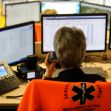In 2013, in a motel room in Marshall, Texas, Kari Hunt was murdered by her estranged husband with her three children just a few feet away. Her oldest, Breonna Hunt, picked up the room phone to call the police in an attempt to save her mother’s life. The nine-year-old dialed 911 four times. “Papa, I tried,” she told her grandfather, Hank Hunt. “But I couldn’t do it.” The nine-year-old was taught to dial 911 in case of emergency; she was unaware that this particular phone required she dial “9” for an outside line.
The murder of Kari Hunt was a tragedy that helped expose a systemic issue of emergency response efforts. Hotels, office buildings, and even school campuses share a common denominator with the incident: multi-line telephone systems (MLTS).
At the time of Kari’s murder, only 18 states had laws concerning 911 calls on MLTS, without a multi-tiered federal approach to public emergency access on such phone systems. After his daughter’s murder, Hank Hunt made a promise to his granddaughter and began working to address that gap in regulations. He launched an earnest petition on Change.org, tasking the U.S. Congress and Senate with a call to action. “Being able to call 911, come on people,” he said in an official FCC podcast. “It’s got to be simple.”
His work led the Federal Communications Commission (FCC) to look into solutions via a provision in the 2014 Congressional Middle Class and Tax Relief Bill. Though a theoretically daunting goal to change such a prevalent phone system, the study surprised FCC chairman Ajit Pai. “In many cases, the fix is pretty easy,” he said. “I mean, even here at the FCC, we didn’t have direct access to 911.” The FCC’s findings showed that the necessary changes to MLTS were readily and pervasively achievable.
On February 16, 2018, the Hunt family met with President Donald Trump in the Oval Office to officially see their years of advocacy signed into action. Kari’s Law of 2017, known as Kari’s Law, amended the Communications Act of 1934. The Report and Order stand as a promise
fulfilled to Hank Hunt’s granddaughter, and to the public itself, to shape a future in which access to help cannot be tragically subverted.
Kari’s Law requires any MLTS manufactured, sold, installed, or utilized in the United States to be configured to dial 911 without any additional codes, digits, prefixes, or postfixes—even if other calls made from the system require such additions. Furthermore, whenever a 911 call is made from an MLTS, the system must be configured to notify personnel and include a call-back number to aid emergency responders in locating the call’s source and hasten response time. On-site, the 911 call cannot be “canceled” by local security or others.
To offset the cost of implementation, Kari’s Law was forward-thinking, applying to systems made, installed, imported, or sold after the February 16, 2020 compliance date (two years after the law’s enactment). Other technologies that may be used for emergency calls, such as voice over IP (VoIP), are included with MLTS in the regulations.
The Hunt family’s story was not alone in catalyzing emergency access legislation. Passed alongside Kari’s Law was RAY BAUM’s Act, which adds further regulations to MLTS phones concerning detailed location and notification information. Enhanced 911 (E911) technology sends location information to public-safety answering points (PSAPs, generally known as 911 call centers), but a multi-line phone system may contain up to thousands of different lines registered under a single location. This makes it impossible for PSAPs to accurately locate the origin of the calls without more information, which isn’t necessarily easy to get in an emergency.
For example, in 2006, Kaafee Billah called the police from his office in Maryland requesting medical assistance and was unable to communicate his exact location on the phone. He worked in one of several MedImmune Inc. buildings in the area, but, because of the typical MLTS configuration, police arrived at an adjacent building. Despite multiple buildings within the system’s network, his call traced back to the MLTS’s nearby registered location and had not triggered central notification to the corporation, so the front desk was unaware and unable to assist emergency responders in locating the call’s actual origin. Billah’s body was later found by a co-worker, ten hours after his 911 call.
The new statute seeks to address such roadblocks in emergency service: section 506 of RAY BAUM’s Act requires that MLTS utilize E911 technology to provide a dispatchable location with every 911 call. They must convey not just a street address but additional and potentially life-saving information, such as room and floor numbers. These obligations have later compliance dates, going into effect January 6 of 2021 and 2022.
Liability under Kari’s Law (and the supplementary RAY BAUM’s Act) is placed not only with the manufacturers and sellers of the equipment but also on the enterprises themselves operating or managing the MLTS. Therefore, even a “passive enterprise owner,” which contracts with a third party for the use of MLTS, must include compliance requirements in their agreement terms with the third party. The manager of the MLTS holds ultimate responsibility to ensure that the dictated obligations are met, or fines can rack up to $10,000 in cases of noncompliance.
Luckily, with Kari’s Law, compliance is often a simple matter of testing and confirming the efficacy of the MLTS configuration. The laws are not meant to cause financial stress to business, but to guide outdated systems and previously nonexistent regulations into a modern era, in which help isn’t curtailed by haphazard details.
The resulting legislation took years of work and, though it will not be perfectly implemented all at once, it is a significant step toward better, safer public use of 911. With the Hunt family’s work, at the very least, a single digit will no longer stand between a little girl and help. As Hank put it: it really should be that simple.






